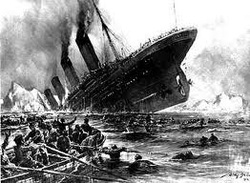
To embrace the truth I realized that I had to be willing to let go of many beliefs, or "strongholds" that had been firmly rooted in my mind and my "belief system" for many years. It was very difficult and emotionally painful to realize that I had to change my way of thinking, speaking and doing.
One famous example that demonstrates the dangers of "believing a lie" is the sinking of the HMS Titanic in 1912. The story of the Titanic is so famous partly because of the extreme irony that the story contains. Basically the sinking of the Titanic was brought about by a series of events or "smaller truths" shall we say, that combined to form one larger truth that no one knew or believed on the fateful night of April 12, 1912.
You see the truth was, that the Titanic had some major construction flaws, discovered in recent years, that were unknown to the owner, the builder, the ships captain, it's crew and it's passengers. To make matters worse, the press was so enamored with this new ship, the largest and most expensive ever built at the time, that they declared it to be"unsinkable". This idea was promoted over and over in the run up to Titanic's maiden voyage. By the time the ship left port, headed for Ireland and then New York, everyone believed that the ship was truly unsinkable. But unfortunately that was not the truth. It mattered not that everyone believed it was the truth.
When Titanic struck the iceberg, most passengers were not even worried initially, because after all, they "knew" that the ship was unsinkable. They had no way of knowing that they were believing a lie. As a result, many passengers and crew failed to respond adequately to the emergency that was truly about to come upon them. About two thirds of all the passengers and most of the crew, including the Captain, lost their lives. Had more of the passengers actually known the truth, that the ship was really going to sink, many more of them would have been saved. But instead, they chose to believe a lie, and it cost them their lives.
